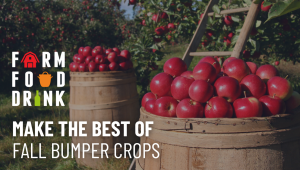So you’ve decided that this year’s bumper crop might just be the catalyst for your next value-added product line. Maybe it’s those overflowing berry bins that have you dreaming of jam labels, or perhaps the mountain of carrots has sparked thoughts of pickled possibilities. The leap from fresh produce to shelf-stable products involves more than just cooking in larger batches, but don’t let that intimidate you. Turning your farm’s harvest into a branded, packaged product is one of the most exciting ways to grow your local food business and connect with customers across Canada.
Production Reality Check
The first question isn’t “Can I make great jam?” (we know you can). It’s “Do I have the capacity to make it consistently, safely, and profitably as a value-added product?
Time and space considerations: Processing farm-grown ingredients for food product production takes time and energy. Factor in prep work, cooking, cooling, packaging, and cleanup. Your home kitchen might make incredible preserves, but scaling up often means different requirements.
Staff resources: Can you handle the additional workload, or will you need extra hands? Food production requires focused attention that can be difficult to juggle alongside regular farm operations. Building a production plan that accounts for staff time and seasonal demands will save you stress down the road.
Navigating Requirements
Local regulations: Canadian food laws vary dramatically by province and municipality. Some allow home-based food production up to certain dollar thresholds, while others require commercial facilities from day one. Start by checking with your local public health unit or provincial food safety authority to understand what’s required in your region.
Commercial kitchen access: If needed, you have options, shared commercial kitchens, partnering with existing food businesses during off-hours, or eventually investing in your own facilities.
Professional presentation: Even the most delicious product needs strong branding and packaging. This is where investing in professional branding and label design pays dividends. Your jam might taste better than anything in stores or at the market, but customers make split-second visual decisions.
Investment Reality
Initial costs for value-added food product development might include commercial kitchen rental, equipment, packaging, labelling, and licensing fees. Start small and scale up as you prove the market. While value-added products can deliver higher margins than fresh produce, they also require more investment of time and money- so you need to build your pricing strategy accordingly.
The key is starting with solid fundamentals: reliable processes, proper licensing, professional presentation, and realistic financial planning.
Need help navigating the practical steps? Our team at Farm Food Drink helps Canadian food producers move from concept to shelf-ready products. Be it market research to determine an effective pricing strategy, business planning to determine viability and growth, creative brand and label design, or an effective marketing strategy on a limited budget, we can help!
Contact Us: hello@farmfooddrink.ca
Farm Food Drink is a team of food research, planning, marketing and training specialists who focus solely on Canadian farm, food, and drink businesses. We provide an integrated, 360 approach and are committed to working alongside our clients as they grow their businesses.
Further Reading

How Canadian Agri-Food Producers Can Better Utilize Fall Bumper Crops
There’s nothing quite like the mixed blessing of a bumper crop. But what if it isn’t a problem to solve, but an opportunity?




![Don’t wait, take photos now! [updated]](https://farmfooddrink.ca/wp-content/uploads/2023/07/Website-Now-Live-1-500x500.png)